Bridging the Gap between Physical and Circuit Analysis for Variability-Aware Microwave Design: Modeling Approaches
Abstract
1. Introduction
2. Block-Wise Stage Simulation through Black-Box Models
- incremental approach: repeated physical simulations are carried out, varying each technological parameter and on a set of prescribed values and , respectively. A family of models and are extracted and fed to the EDA tool, where interpolation among these models allows for statistical analysis or optimization with continuously varying and ;
- linearized approach: when variations are small, physical simulations are used to assess the sensitivity of the given nominal model to each of the i-th parameter variations
- incremental approach: repeated physical simulations with varying incident waves (magnitude and phase) yield a set of reflected waves and a family of models. Interpolation allows us to incorporate them into EDA tools;
- linearized approach: the models must be linearized as a function of the incident waves .
3. Passive Block Black-Box Models
3.1. Case (1L): Look-Up Table MDIF File
3.2. Case (2L): Equivalent PIV Generators
4. Active Device Black-Box Model
- is identified with the elements of
- is identified with the elements of
4.1. Case (1NL): Look-Up Table X-Parameters
4.2. Case (2NL): X-Parameters with Equivalent PIV Generators
- Case (2NL) provides a simple way to couple experimental Xpar characterization on a limited set of sample (“nominal”) devices with the equivalent PIV generators extracted in an independent way, i.e., through physical simulations. This would avoid the time-consuming and costly statistical characterization campaigns on a given technology, a procedure well beyond the typical laboratory capabilities usually available to microwave designers.
- Green’s functions allow for a dramatic reduction of the model extraction time when we address concurrent multiple variations of technological parameters; in fact, GFs must be calculated just once with the nominal parameter values, and equivalent port generators are readily calculated for all variations. Hence, case (2NL) avoiding the multidimensional interpolation of look-up-table data, may turn out to be more robust from the numerical standpoint. However, linearization also implies that multiple uncorrelated parameters will also induce fully uncorrelated equivalent PIV generators, a result that has been proven wrong in some aggressively downscaled technologies [50].
- Green’s functions allow us to easily address the effect of local fluctuations [38]. Although in this paper we restricted the analysis to global variations, local variations (also statistical in nature) are quite usual in silicon technologies, e.g., for random doping fluctuations [50]. Nonetheless, the efficient calculation of GFs in TCAD is not at all conventional. Up to now, GF-based variability analysis within the harmonic balance approach (i.e., for nonlinear large signal applications) is unique to our in-house software [29], and it is not available in any commercial simulator (indeed Synopsys Sentaurus [27] does implement a GF-based variability analysis, but limited to the DC case only).
5. Conclusions
Author Contributions
Funding
Conflicts of Interest
References
- Lee, H.J.; Callender, S.; Rami, S.; Shin, W.; Yu, Q.; Marulanda, J.M. Intel 22nm Low-Power FinFET (22FFL) Process Technology for 5G and Beyond. In Proceedings of the 2020 IEEE Custom Integrated Circuits Conference (CICC), Newport Beach, CA, USA, 22–25 March 2020. [Google Scholar] [CrossRef]
- Lin, H.C.; Chou, T.; Chung, C.C.; Tsen, C.J.; Huang, B.W.; Liu, C.W. RF Performance of Stacked Si Nanosheet nFETs. IEEE Trans. Electron Devices 2021, 68, 5277–5283. [Google Scholar] [CrossRef]
- Wang, Z.; Wang, H.; Heydari, P. CMOS Power-Amplifier Design Perspectives for 6G Wireless Communications. In Proceedings of the 2021 IEEE International Midwest Symposium on Circuits and Systems (MWSCAS), East Lansing, MI, USA, 8–11 August 2021. [Google Scholar] [CrossRef]
- Raskin, J.P. FinFET versus UTBB SOI—A RF perspective. In Proceedings of the 2015 45th European Solid State Device Research Conference (ESSDERC), Graz, Austria, 14–18 September 2015. [Google Scholar] [CrossRef]
- Collaert, N.; Alian, A.; Banerjee, A.; Chauhan, V.; ElKashlan, R.Y.; Hsu, B.; Ingels, M.; Khaled, A.; Kodandarama, K.V.; Kunert, B.; et al. From 5G to 6G: Will compound semiconductors make the difference? In Proceedings of the 2020 IEEE 15th International Conference on Solid-State & Integrated Circuit Technology (ICSICT), Kunming, China, 3–6 November 2020. [Google Scholar] [CrossRef]
- Poluri, N.; DeSouza, M.M.; Venkatesan, N.; Fay, P. Modelling Challenges for Enabling High Performance Amplifiers in 5G/6G Applications. In Proceedings of the 2021 28th International Conference on Mixed Design of Integrated Circuits and System, Lodz, Poland, 24–26 June 2021. [Google Scholar] [CrossRef]
- White Paper on RF Enabling 6G—Opportunities And Challenges From Technology To Spectrum; Technical Report; University of Oulu: Oulu, Finland, 2021; Available online: https://www.keysight.com/us/en/assets/7121-1085/article-reprints/RF-Enabling-6G-Opportunities-and-Challenges-from-Technology-to-Spectrum.pdf (accessed on 30 January 2022).
- Camarchia, V.; Donati Guerrieri, S.; Ghione, G.; Pirola, M.; Quaglia, R.; Rubio, J.J.M.; Loran, B.; Palomba, F.; Sivverini, G. A K-band GaAs MMIC Doherty power amplifier for point-to-point microwave backhaul applications. In Proceedings of the 2014 International Workshop on Integrated Nonlinear Microwave and Millimetre-wave Circuits (INMMiC), Leuven, Belgium, 2–4 April 2014. [Google Scholar] [CrossRef]
- Mao, S.; Zhang, W.; Yao, Y.; Yu, X.; Tao, H.; Guo, F.; Ren, C.; Chen, T.; Zhang, B.; Xu, R.; et al. A Yield-Improvement Method for Millimeter-Wave GaN MMIC Power Amplifier Design Based on Load—Pull Analysis. IEEE Trans. Microw. Theory Tech. 2021, 69, 3883–3895. [Google Scholar] [CrossRef]
- Bonani, F.; Camarchia, V.; Cappelluti, F.; Donati Guerrieri, S.; Ghione, G.; Pirola, M. When self-consistency makes a difference. IEEE Microw. Mag. 2008, 9, 81–89. [Google Scholar] [CrossRef][Green Version]
- Ramella, C.; Pirola, M.; Reale, A.; Ramundo, M.; Colantonio, P.; Maur, M.A.D.; Camarchia, V.; Piacibello, A.; Giofrè, R. Thermal-aware GaN/Si MMIC design for space applications. In Proceedings of the IEEE International Conference on Microwaves, Communications, Antennas, and Electronic Systems (IEEE COMCAS 2019), Tel-Aviv, Israel, 4–6 November 2019; pp. 1–6. [Google Scholar] [CrossRef]
- Wen, Z.; Mao, S.; Wu, Y.; Xu, R.; Yan, B.; Xu, Y. A Quasi-Physical Large-Signal Statistical Model for 0.15 μm AlGaN/GaN HEMTs Process. In Proceedings of the 2019 IEEE MTT-S International Microwave Symposium (IMS), Boston, MA, USA, 2–7 June 2019. [Google Scholar] [CrossRef]
- Williams, S.; Varahramyan, K. A new TCAD-based statistical methodology for the optimization and sensitivity analysis of semiconductor technologies. IEEE Trans. Semicond. Manuf. 2000, 13, 208–218. [Google Scholar] [CrossRef]
- Chordia, A.; Hemaram, S.; Tripathi, J.N. A Swarm Intelligence based Automated Framework for Variability Analysis. In Proceedings of the 2020 IEEE MTT-S Latin America Microwave Conference (LAMC 2020), Cali, Colombia, 26–28 May 2021. [Google Scholar] [CrossRef]
- Geng, M.; Zhu, Z.; Cai, J. Small-Signal Behavioral Model for GaN HEMTs based on Long-Short Term Memory Networks. In Proceedings of the 2021 IEEE MTT-S International Wireless Symposium (IWS), Nanjing, China, 23–26 May 2021. [Google Scholar] [CrossRef]
- Hu, W.; Luo, H.; Yan, X.; Guo, Y.X. An Accurate Neural Network-Based Consistent Gate Charge Model for GaN HEMTs by Refining Intrinsic Capacitances. IEEE Trans. Microw. Theory Tech. 2021, 69, 3208–3218. [Google Scholar] [CrossRef]
- Orengo, G.; Colantonio, P.; Giannini, F.; Pirola, M.; Camarchia, V.; Donati Guerrieri, S. Advanced Neural Network Techniques for GaN-HEMT Dynamic Behavior Characterization. In Proceedings of the 2006 European Microwave Integrated Circuits Conference, Manchester, UK, 10–13 September 2006. [Google Scholar] [CrossRef]
- Root, D.; Verspecht, J.; Horn, J.; Marcu, M. X-Parameters: Characterization, Modeling, and Design of Nonlinear RF and Microwave Components; Cambridge University Press: Cambridge, UK, 2013. [Google Scholar]
- Keysight ADS. Available online: https://www.keysight.com/zz/en/products/software/pathwave-design-software/pathwave-advanced-design-system.html (accessed on 30 January 2022).
- Cadence AWR Microwave Office. Available online: https://www.awr.com/awr-software/products/microwave-office (accessed on 30 January 2022).
- Ansys HFSS. Available online: https://www.ansys.com/it-it/products/electronics/ansys-hfss (accessed on 30 January 2022).
- Cadence AWR Analyst. Available online: https://www.awr.com/awr-software/products/analyst (accessed on 30 January 2022).
- Comsol Multiphysics. Available online: https://www.comsol.com/products (accessed on 30 January 2022).
- Keysight Momentum. Available online: https://www.keysight.com/it/en/product/W3031E/pathwave-momentum.html (accessed on 30 January 2022).
- Cadence AWR Axiem. Available online: https://www.cadence.com/en_US/home/tools/system-analysis/rf-microwave-design/awr-axiem-analysis.html (accessed on 30 January 2022).
- Sonnet. Available online: https://www.sonnetsoftware.com/products/sonnet-suites/ (accessed on 30 January 2022).
- Synopsys Sentaurus. Available online: https://www.synopsys.com/silicon/tcad/device-simulation/sentaurus-device.html (accessed on 30 January 2022).
- Silvaco Victory Device. Available online: https://silvaco.com/tcad/victory-device-3d/ (accessed on 30 January 2022).
- Donati Guerrieri, S.; Pirola, M.; Bonani, F. Concurrent Efficient Evaluation of Small-Change Parameters and Green’s Functions for TCAD Device Noise and Variability Analysis. IEEE Trans. Electron Devices 2017, 64, 1269–1275. [Google Scholar] [CrossRef]
- Catoggio, E.; Donati Guerrieri, S.; Bonani, F. Efficient TCAD Thermal Analysis of Semiconductor Devices. IEEE Trans. Electron Devices 2021, 68, 5462–5468. [Google Scholar] [CrossRef]
- Keysight PathWave Thermal Design. Available online: https://www.keysight.com/it/en/products/software/pathwave-design-software/pathwave-thermal-design-software.html (accessed on 30 January 2022).
- Capesym Symmic. Available online: https://www.capesym.com/symmic.html (accessed on 30 January 2022).
- Ghione, G.; Pirola, M. Microwave Electronics; Cambridge University Press: Cambridge, UK, 2019. [Google Scholar]
- Dutton, R.; Troyanovsky, B.; Yu, Z.; Arnborg, T.; Rotella, F.; Ma, G.; Sato-Iwanaga, J. Device simulation for RF applications. In Proceedings of the International Electron Devices Meeting, IEDM Technical Digest, Washington, DC, USA, 10 December 1997; pp. 301–304. [Google Scholar] [CrossRef]
- Bonani, F.; Donati Guerrieri, S.; Ghione, G.; Pirola, M. A TCAD approach to the physics-based modeling of frequency conversion and noise in semiconductor devices under large-signal forced operation. IEEE Trans. Electron Devices 2001, 48, 966–977. [Google Scholar] [CrossRef]
- Bertazzi, F.; Bonani, F.; Donati Guerrieri, S.; Ghione, G. Large-signal device simulation in time- and frequency-domain: A comparison. COMPEL—Int. J. Comput. Math. Electr. Electron. Eng. 2008, 27, 1319–1325. [Google Scholar] [CrossRef][Green Version]
- Guerra, D.; Saraniti, M.; Ferry, D.K.; Goodnick, S.M. X-parameters and efficient physical device simulation of mm-wave power transistors with harmonic loading. In Proceedings of the 2014 IEEE MTT-S International Microwave Symposium (IMS2014), Tampa, FL, USA, 1–6 June 2014. [Google Scholar] [CrossRef]
- Donati Guerrieri, S.; Bonani, F.; Bertazzi, F.; Ghione, G. A Unified Approach to the Sensitivity and Variability Physics-Based Modeling of Semiconductor Devices Operated in Dynamic Conditions—Part I: Large-Signal Sensitivity. IEEE Trans. Electron Devices 2016, 63, 1195–1201. [Google Scholar] [CrossRef]
- Donati Guerrieri, S.; Bonani, F.; Bertazzi, F.; Ghione, G. A Unified Approach to the Sensitivity and Variability Physics-Based Modeling of Semiconductor Devices Operated in Dynamic Conditions.—Part II: Small-signal and Conversion Matrix Sensitivity. IEEE Trans. Electron Devices 2016, 63, 1202–1208. [Google Scholar] [CrossRef]
- Donati Guerrieri, S.; Bonani, F.; Ghione, G. Linking X Parameters to Physical Simulations For Design-Oriented Large-Signal Device Variability Modeling. In Proceedings of the 2019 IEEE MTT-S International Microwave Symposium (IMS), Boston, MA, USA, 2–7 June 2019. [Google Scholar] [CrossRef]
- Donati Guerrieri, S.; Ramella, C.; Bonani, F.; Ghione, G. Efficient Sensitivity and Variability Analysis of Nonlinear Microwave Stages Through Concurrent TCAD and EM Modeling. IEEE J. Multiscale Multiphys. Comput. Tech. 2019, 4, 356–363. [Google Scholar] [CrossRef]
- Donati Guerrieri, S.; Ramella, C.; Bonani, F.; Ghione, G. PA design and statistical analysis through X-par driven load-pull and EM simulations. In Proceedings of the 2020 International Workshop on Integrated Nonlinear Microwave and Millimetre-Wave Circuits (INMMiC), Cardiff, UK, 16–17 July 2020. [Google Scholar] [CrossRef]
- Bonani, F.; Ghione, G. Noise in Semiconductor Devices; Springer: Berlin/Heidelberg, Germany, 2001. [Google Scholar]
- Root, D.; Verspecht, J.; Sharrit, D.; Wood, J.; Cognata, A. Broad-band poly-harmonic distortion (PHD) behavioral models from fast automated simulations and large-signal vectorial network measurements. IEEE Trans. Microw. Theory Tech. 2005, 53, 3656–3664. [Google Scholar] [CrossRef]
- Maas, S. Nonlinear Microwave and RF Circuits; Artech House: Boston, MA, USA, 2003. [Google Scholar]
- Bonani, F.; Donati Guerrieri, S.; Filicori, F.; Ghione, G.; Pirola, M. Physics-based large-signal sensitivity analysis of microwave circuits using technological parametric sensitivity from multidimensional semiconductor device models. IEEE Trans. Microw. Theory Tech. 1997, 45, 846–855. [Google Scholar] [CrossRef]
- Donati Guerrieri, S.; Bonani, F.; Ghione, G. A novel approach to microwave circuit large-signal variability analysis through efficient device sensitivity-based physical modeling. In Proceedings of the 2016 IEEE MTT-S International Microwave Symposium (IMS), San Francisco, CA, USA, 22–27 May 2016. [Google Scholar] [CrossRef]
- Donati Guerrieri, S.; Bonani, F.; Ghione, G. A comprehensive technique for the assessment of microwave circuit design variability through physical simulations. In Proceedings of the 2017 IEEE MTT-S International Microwave Symposium (IMS), Boston, MA, USA, 2–7 June 2017. [Google Scholar] [CrossRef]
- Bughio, A.M.; Donati Guerrieri, S.; Bonani, F.; Ghione, G. Physics-based modeling of FinFET RF variability. In Proceedings of the 2016 11th European Microwave Integrated Circuits Conference (EuMIC), London, UK, 3–4 October 2016. [Google Scholar] [CrossRef]
- Roy, G.; Ghetti, A.; Benvenuti, A.; Erlebach, A.; Asenov, A. Comparative Simulation Study of the Different Sources of Statistical Variability in Contemporary Floating-Gate Nonvolatile Memory. IEEE Trans. Electron Devices 2011, 58, 4155–4163. [Google Scholar] [CrossRef]

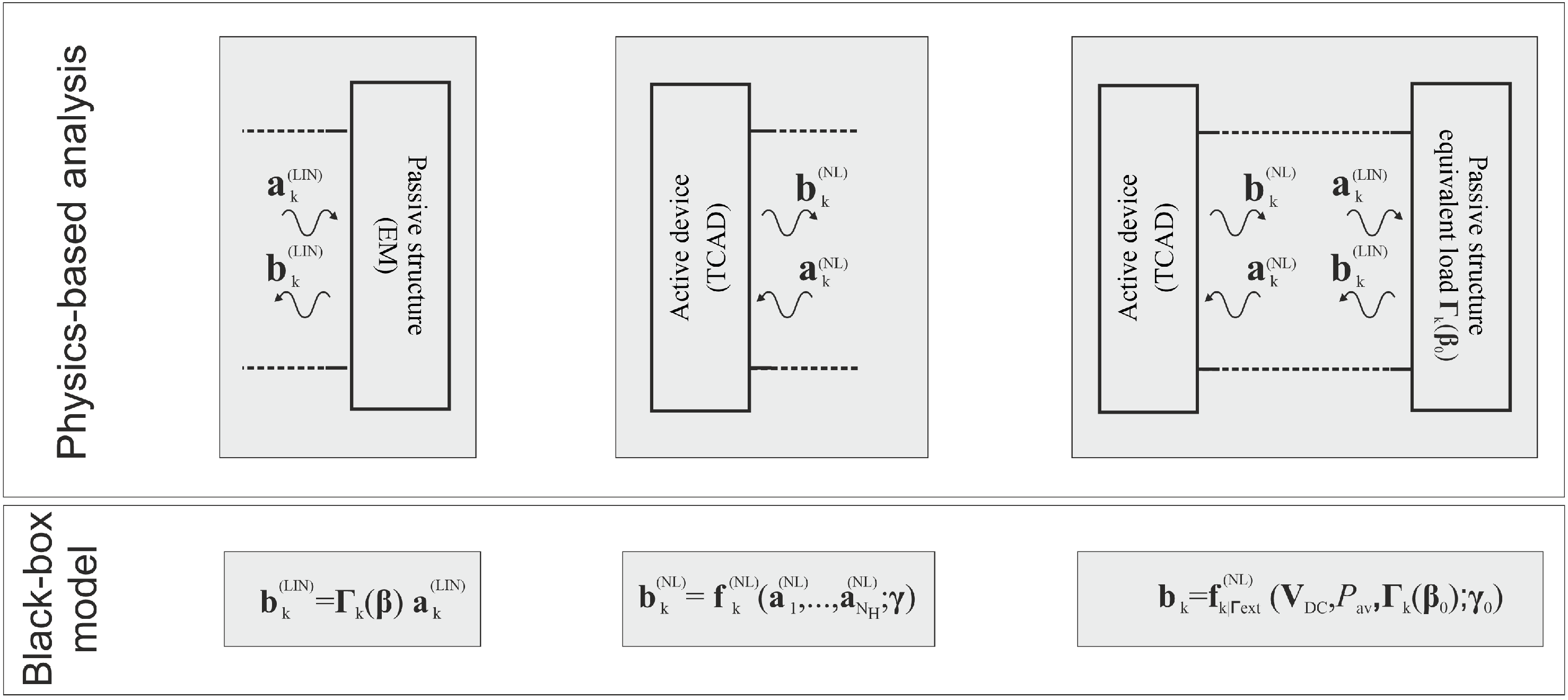
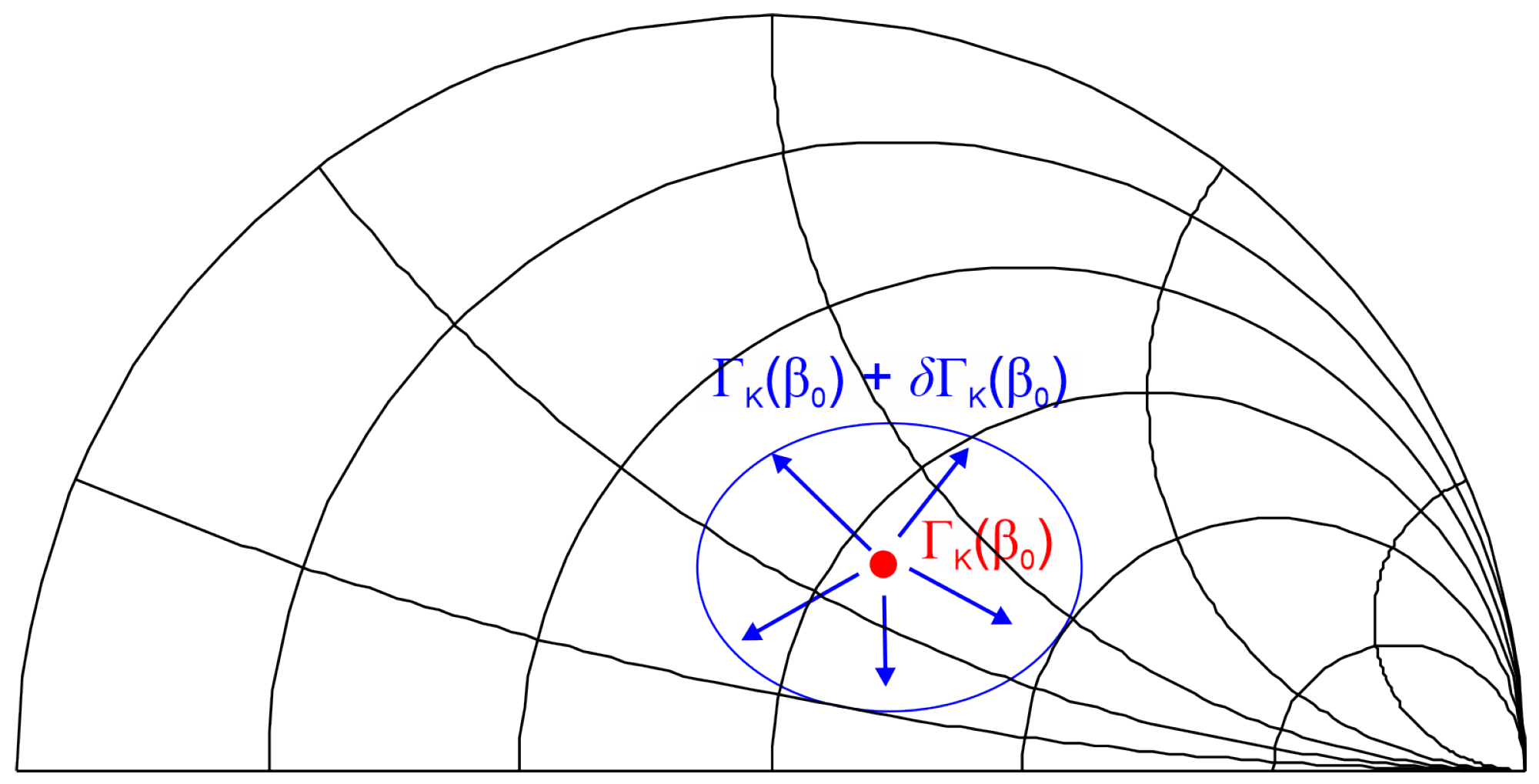


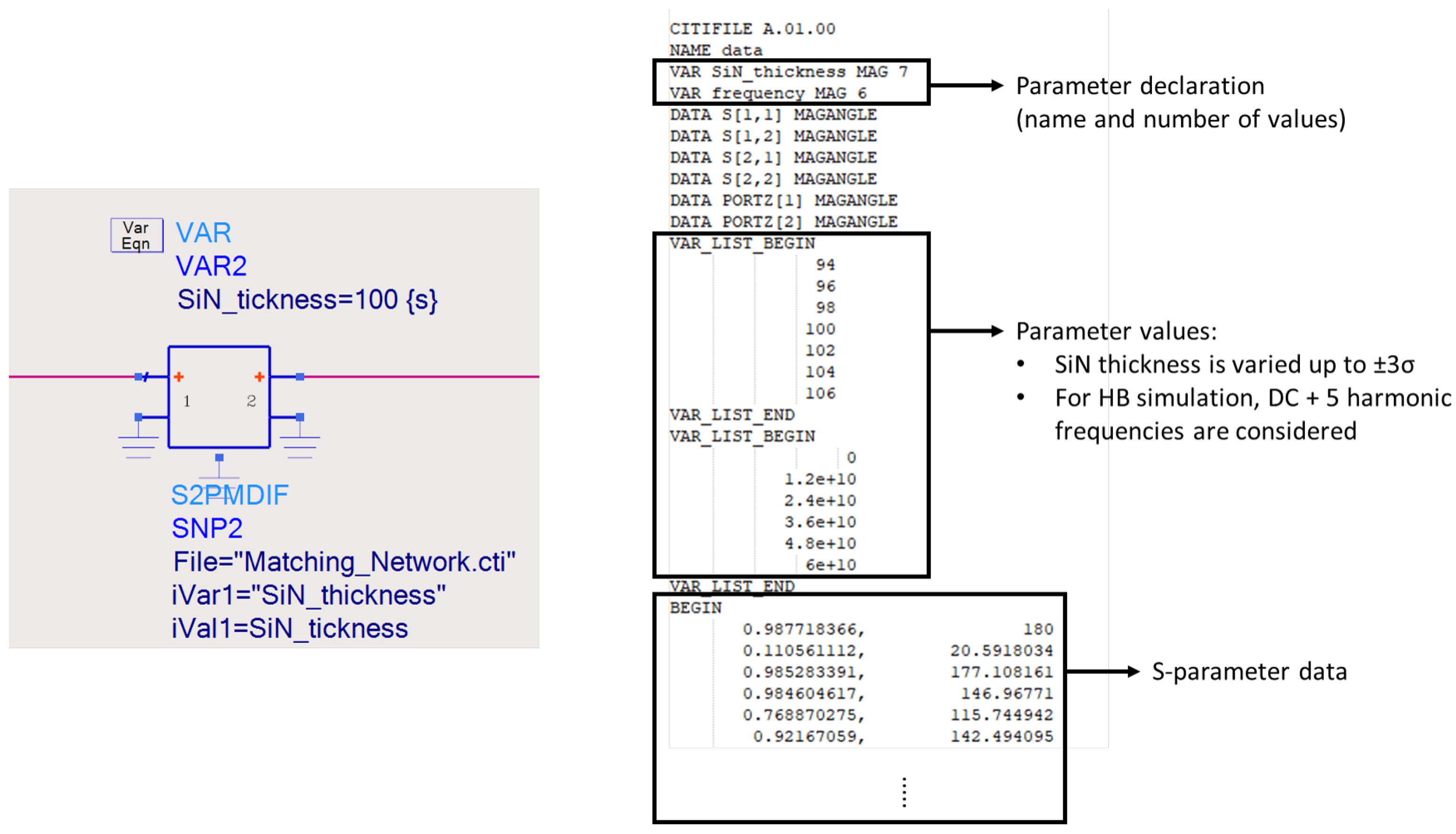
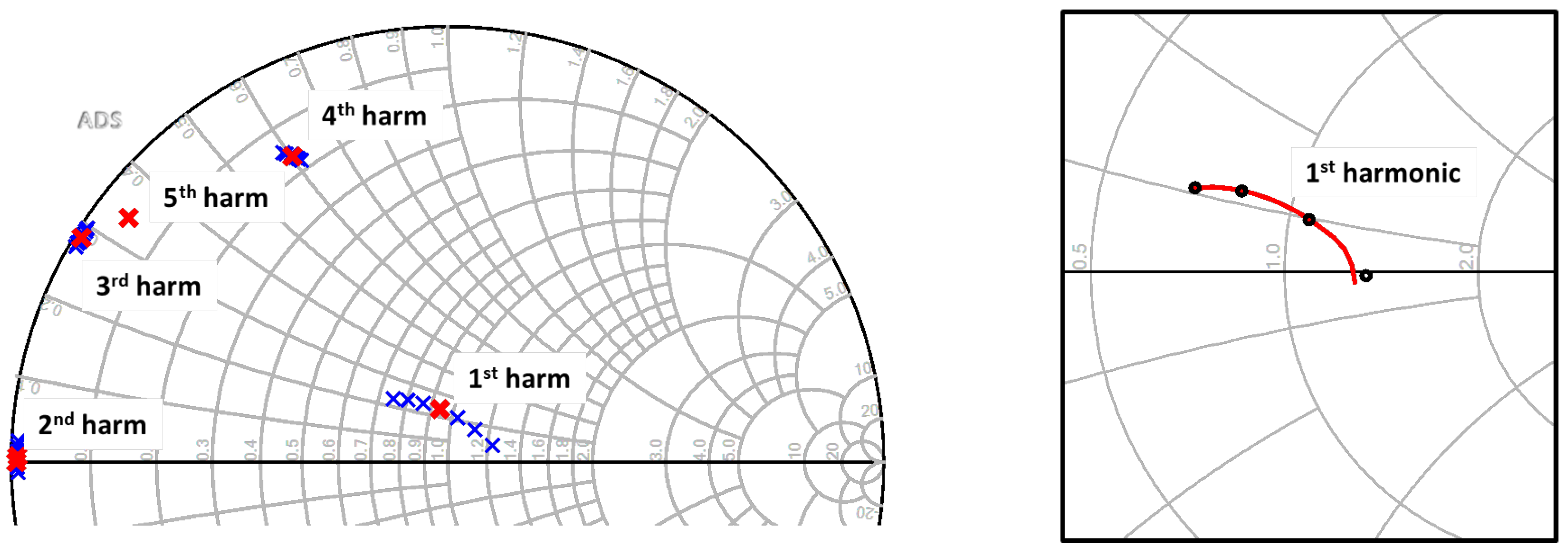
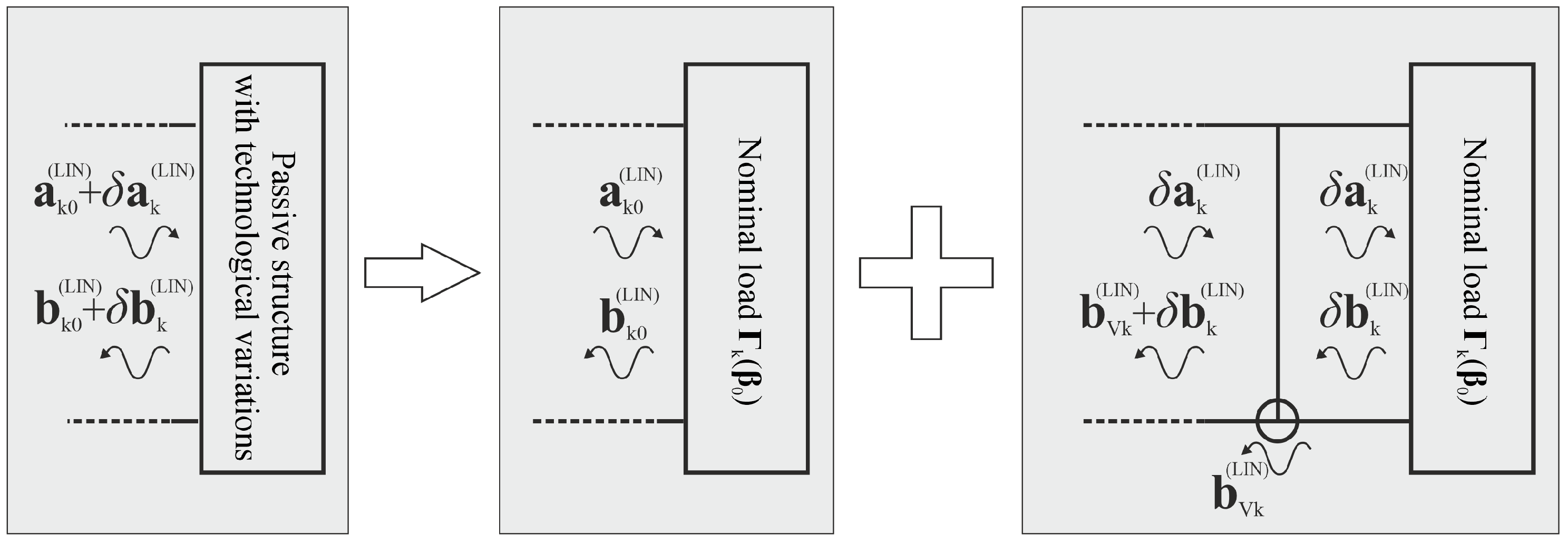
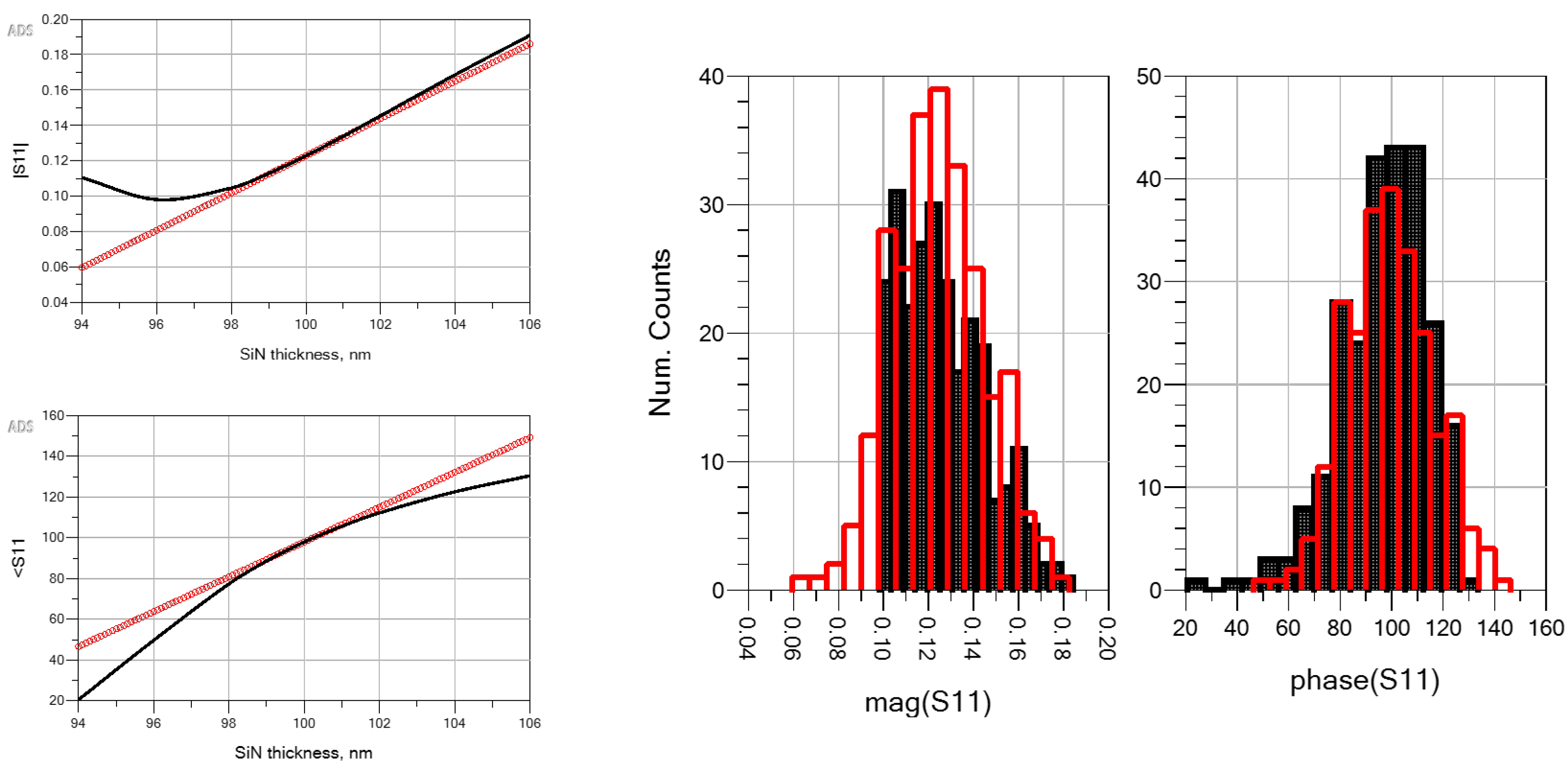
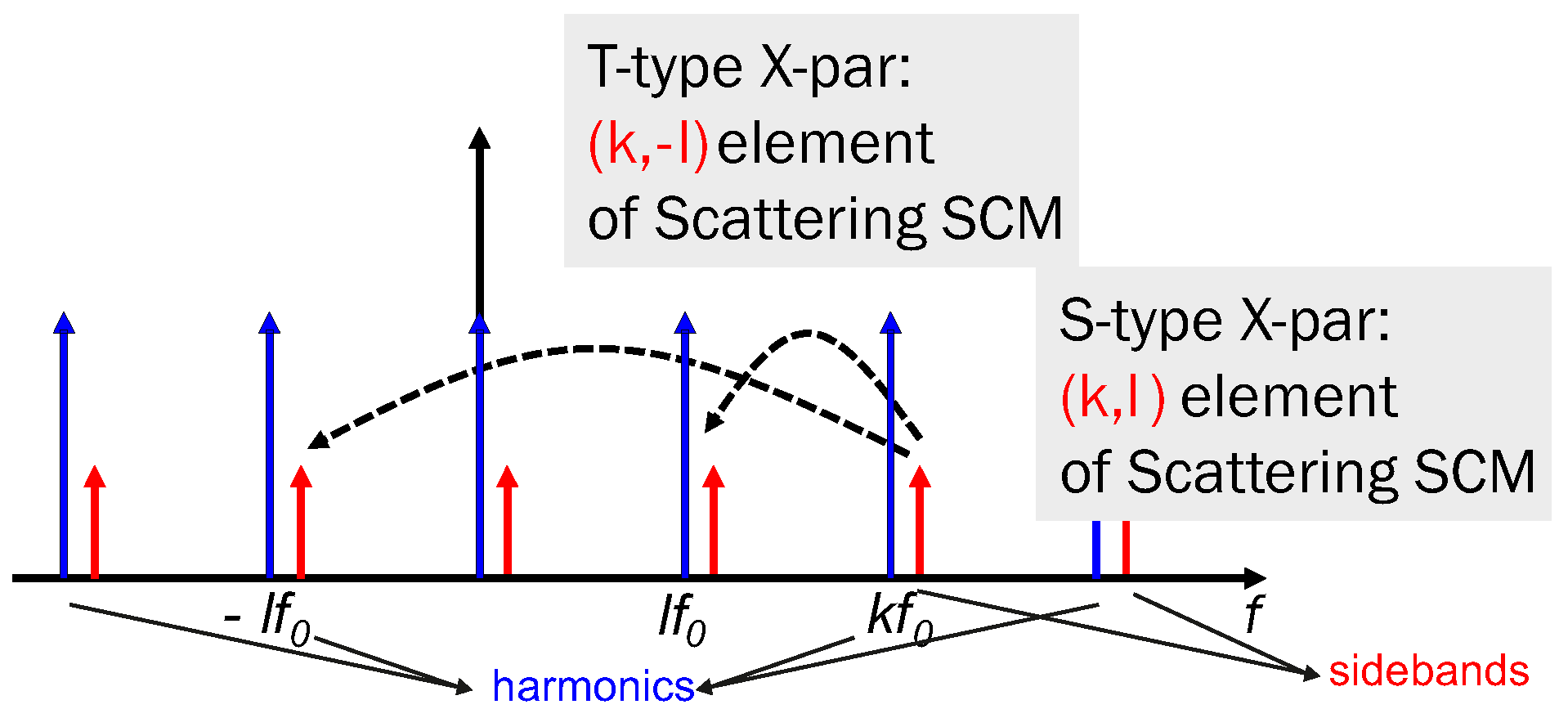
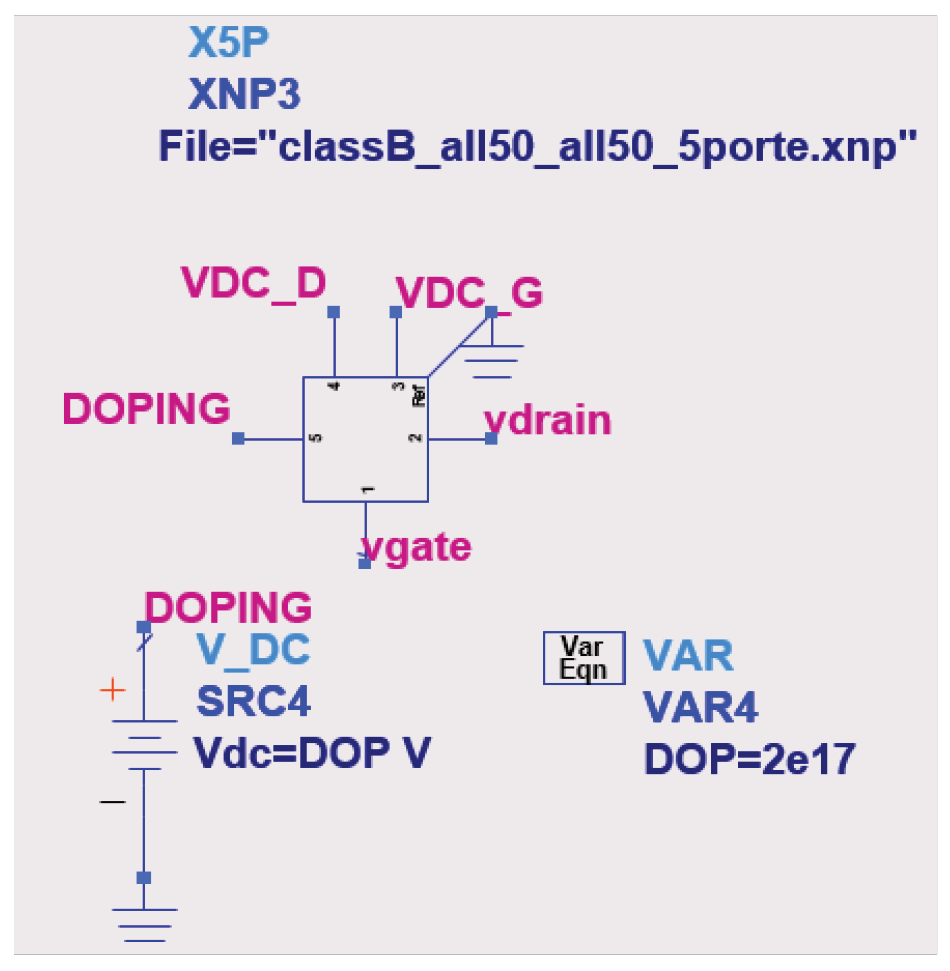




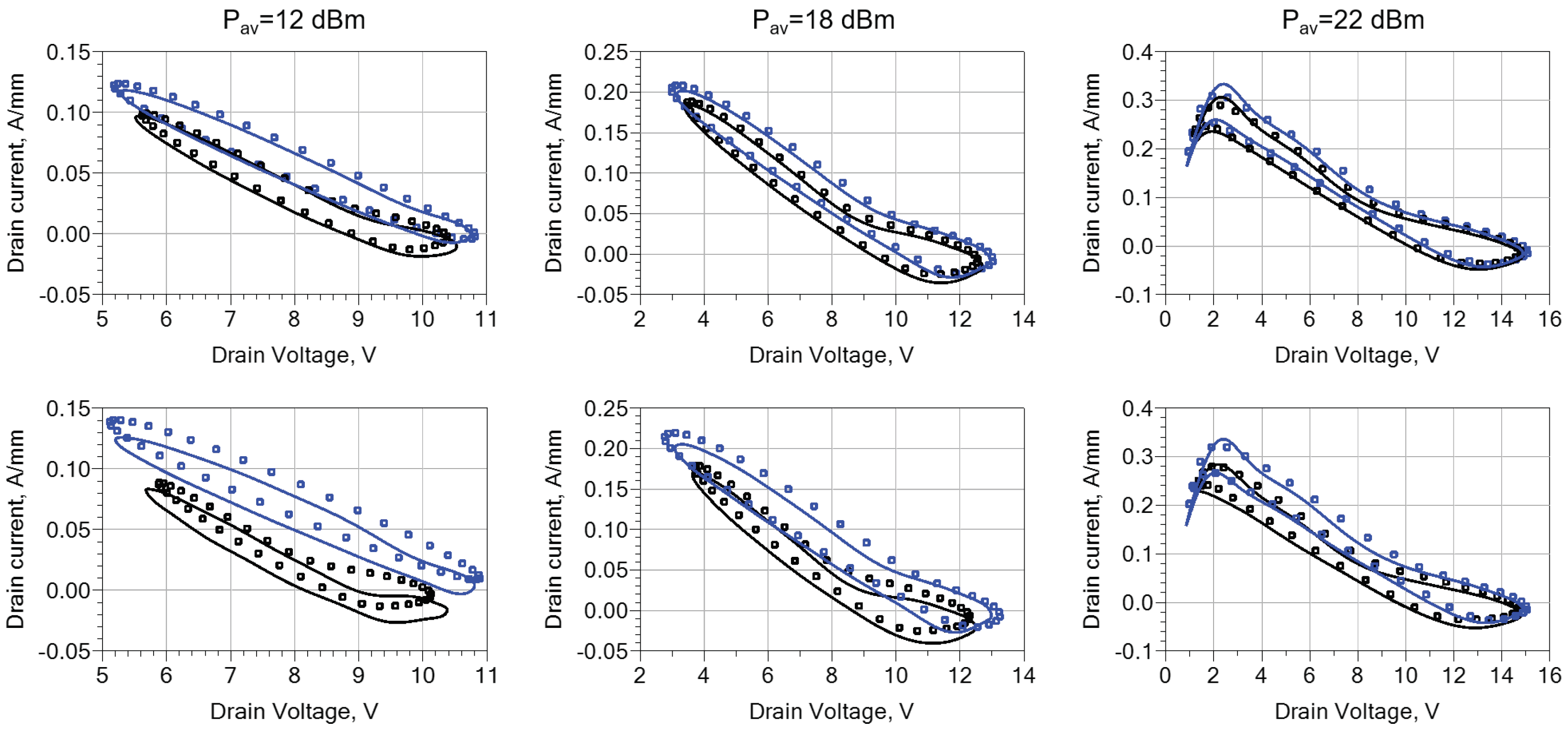
Publisher’s Note: MDPI stays neutral with regard to jurisdictional claims in published maps and institutional affiliations. |
© 2022 by the authors. Licensee MDPI, Basel, Switzerland. This article is an open access article distributed under the terms and conditions of the Creative Commons Attribution (CC BY) license (https://creativecommons.org/licenses/by/4.0/).
Share and Cite
Donati Guerrieri, S.; Ramella, C.; Catoggio, E.; Bonani, F. Bridging the Gap between Physical and Circuit Analysis for Variability-Aware Microwave Design: Modeling Approaches. Electronics 2022, 11, 860. https://doi.org/10.3390/electronics11060860
Donati Guerrieri S, Ramella C, Catoggio E, Bonani F. Bridging the Gap between Physical and Circuit Analysis for Variability-Aware Microwave Design: Modeling Approaches. Electronics. 2022; 11(6):860. https://doi.org/10.3390/electronics11060860
Chicago/Turabian StyleDonati Guerrieri, Simona, Chiara Ramella, Eva Catoggio, and Fabrizio Bonani. 2022. "Bridging the Gap between Physical and Circuit Analysis for Variability-Aware Microwave Design: Modeling Approaches" Electronics 11, no. 6: 860. https://doi.org/10.3390/electronics11060860
APA StyleDonati Guerrieri, S., Ramella, C., Catoggio, E., & Bonani, F. (2022). Bridging the Gap between Physical and Circuit Analysis for Variability-Aware Microwave Design: Modeling Approaches. Electronics, 11(6), 860. https://doi.org/10.3390/electronics11060860






